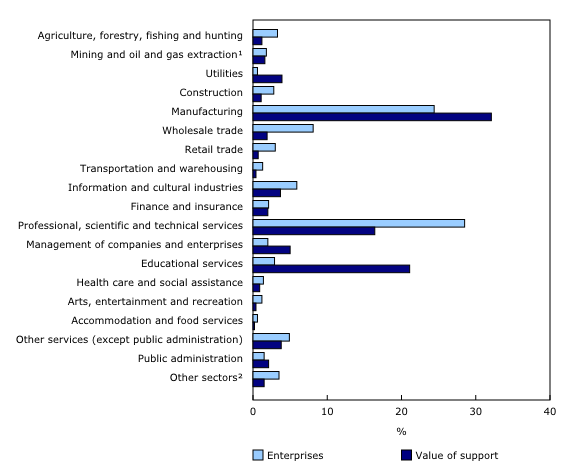Business innovation and growth support, 2007 to 2017
Archived Content
Information identified as archived is provided for reference, research or recordkeeping purposes. It is not subject to the Government of Canada Web Standards and has not been altered or updated since it was archived. Please "contact us" to request a format other than those available.
Released: 2020-01-16
The federal government manages program streams offering business innovation and growth support (BIGS) through its departments and agencies. This support can vary by enterprise size, industry and other characteristics. In this analysis, BIGS administrative data are linked to the Linkable File Environment. The Linkable File Environment facilitates the creation of microdata datasets that pertain to Canadian enterprises. In order to better understand the beneficiaries of this support, the following analysis presents the distribution of federal support in 2017 by enterprise size and industry.
Small- and medium-sized enterprises accounted for the majority of enterprises that received support for business innovation and growth through a federal program stream in 2017, but the average value of support increased markedly with enterprise size. Over one-quarter of the enterprises that received federal support were in the professional, scientific and technical services sector, while almost one-third of the total funds dispersed went to enterprises in the manufacturing sector.
Majority of enterprises that received federal support for innovation and growth were small and medium sized
Small- and medium-sized enterprises accounted for 95.1% of the enterprises that received support for business innovation and growth through a federal program stream in 2017. Large enterprises, with 500 employees or more, accounted for 4.9% of enterprises that received federal support.
Small- and medium-sized enterprises received 54.2% of the total value of federal government support in 2017.
Enterprises with annual revenues of less than $50,000,000 represented 91.8% of enterprises that received federal support for business innovation and growth in 2017, while those with annual revenues of $50,000,000 or more accounted for 8.2% of enterprises that received such support.
The average value of federal support per enterprise increased with the enterprise size
In general, in 2017, the average value of support received per enterprise increased with the size of the enterprise.
For example, the average value of support received by small enterprises was $51,702 in 2017. Medium-sized enterprises received on average $118,230 and large enterprises received $956,954.
The average value of support received by enterprises with annual revenues below $250,000 in 2017 was $20,235. Enterprises with annual revenues from $5,000,000 to $9,999,999 received on average $71,981 and enterprises with annual revenues of $500,000,000 or more received $1,017,373.
The manufacturing sector received almost one-third of the total value of federal business innovation and growth support
The professional, scientific and technical services (28.5%) and manufacturing (24.4%) sectors accounted for the largest shares of enterprises that received business innovation and growth support in Canada in 2017.
In value terms, the manufacturing sector received almost one-third (32.1%) of the total value of support. By comparison, the professional, scientific and technical services sector, which accounted for the largest share of enterprises receiving support, received under one-fifth (16.4%) of the total value of support.
The educational services industry accounted for 2.9% of enterprises that received federal support for innovation and growth. In contrast, in 2017, the value of support to enterprises in this industry represented more than one-fifth (21.1%) of the total amount of support.
Note to readers
Small enterprises are enterprises with fewer than 100 employees in a given year. Medium-sized enterprises employ between 100 and 499 employees annually, while large enterprises employ 500 or more employees in a given year.
The average value of support per firm in a revenue or employment category is expressed as the value of support in an employment or revenue category divided by the number of enterprises in the same category.
The business innovation and growth support database includes a significant number of advisory services as well as enterprises in a consortium with no reported value of support. Some industries may comprise more enterprises that received services, which could affect the average support per firm.
This analysis looks at the 2017 reference year. However, data from 2007 to 2017 are available in the tables. Year-over-year comparisons should be made with caution. Year-over-year differences in the number of enterprises or support values may be the result of changes in departmental financial systems and the unavailability of data rather than changes to the program streams. Overall, data from the most recent years are of better quality and are more complete.
The tables presented include only enterprises, as defined in Statistics Canada's Business Register (BR), that could be linked to the BR and that are the ultimate beneficiaries. An enterprise is considered an ultimate beneficiary when it benefits from the activities of a program stream. Support provided to an ultimate beneficiary may come directly from a federal department or indirectly through an intermediary. For a given program stream, an intermediary cannot be an ultimate beneficiary. For example, ultimate beneficiaries may be for-profit and non-profit enterprises as well as government organizations or educational institutions.
In the Daily article, the total value of support excludes enterprises with unavailable data on employment, revenue or industrial classification. However, in the tables, the total value of support includes these enterprises with unavailable data on employment, revenue or industrial classification.
Contact information
For more information, or to enquire about the concepts, methods or data quality of this release, contact us (toll-free 1-800-263-1136; 514-283-8300; STATCAN.infostats-infostats.STATCAN@canada.ca) or Media Relations (613-951-4636; STATCAN.mediahotline-ligneinfomedias.STATCAN@canada.ca).
- Date modified:




